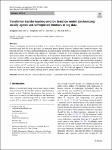Item Infomation
Full metadata record
| DC Field | Value | Language |
|---|---|---|
| dc.contributor.author | Sanghyub John, Lee | - |
| dc.contributor.author | JongYoon, Lim | - |
| dc.contributor.author | Leo, Paas | - |
| dc.date.accessioned | 2023-04-25T06:40:12Z | - |
| dc.date.available | 2023-04-25T06:40:12Z | - |
| dc.date.issued | 2023 | - |
| dc.identifier.uri | https://link.springer.com/article/10.1007/s00521-023-08276-8 | - |
| dc.identifier.uri | https://dlib.phenikaa-uni.edu.vn/handle/PNK/8278 | - |
| dc.description | CC BY | vi |
| dc.description.abstract | Abstract Tactics to determine the emotions of authors of texts such as Twitter messages often rely on multiple annotators who label relatively small data sets of text passages. An alternative method gathers large text databases that contain the authors’ self-reported emotions, to which artificial intelligence, machine learning, and natural language processing tools can be applied. Both approaches have strength and weaknesses. Emotions evaluated by a few human annotators are susceptible to idiosyncratic biases that reflect the characteristics of the annotators. But models based on large, self-reported emotion data sets may overlook subtle, social emotions that human annotators can recognize. | vi |
| dc.language.iso | en | vi |
| dc.publisher | Springer | vi |
| dc.subject | emotions in big data | vi |
| dc.title | Transformer transfer learning emotion detection model synchronizing socially agreed and self-reported emotions in big data | vi |
| dc.type | Book | vi |
| Appears in Collections | ||
| OER - Công nghệ thông tin | ||
Files in This Item:

